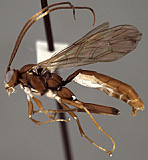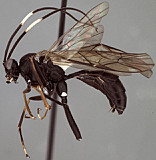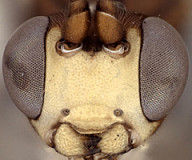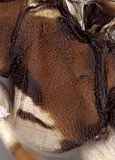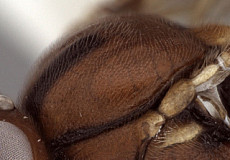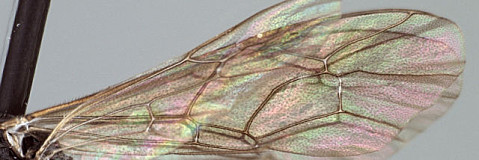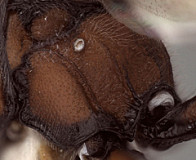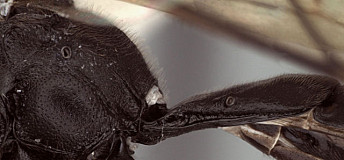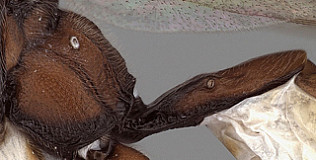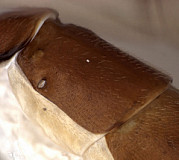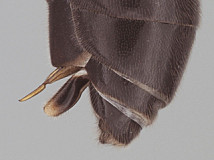Clypeus (Fig. 3) narrow, weakly to strongly bulging subdorsally, with rounded transverse ridge; ventral 0.5-0.7 flat to slightly impressed; margin sharp throughout, truncate to weakly concave medially, lateral margins broadly angled dorsally; epistomal sulcus narrow, distinct. Malar space nearly always shorter than half basal width of mandible, rarely half basal width of mandible. Mandible (Fig. 3) short, curved to strongly curved, usually strongly narrowing from base to about midpoint, with apical portion parallel-sided; dorsal tooth wider and usually a little longer than ventral tooth; ventral margin carinate, sometimes strongly so. Inner eye margins parallel to weakly diverging. Ocelli small, with maximum diameter of lateral ocellus shorter than distance between ocellus and eye. Maxillary palps shorter than height of head. Female (Fig. 2) and male (Fig. 1) antennae about as long as body or slightly shorter; first flagellomere very long and slender, at least twice longer than second (Figs 1, 4). Hypostomal carina joining occipital carina above base of mandible; occipital carina complete. Epomia usually present, sometimes small or apparently absent. Dorsal end of epicnemial carina usually (80%) not extending to anterior margin of mesopleuron (Fig. 5); mesopleuron polished or mat, punctate to coarsely granular punctate to partly rugulose (Fig. 5). Notaulus (Fig. 6) usually short and weakly impressed on anterior declivity (Fig. 6), weak to absent on disk, less commonly (20%) more deeply impressed anteriorly and occasionally with weak sculpture. Pleural carina (Figs 9-11) often distinct as in Fig. 9, but just as often weak and indistinct as in Fig. 10; propodeal carinae reduced: lateral longitudinal carina sometimes distinct but often indistinct; median longitudinal carinae usually (90%) absent or barely indicated as low, rounded irregularities; petiolar area absent or broadly open anteriorly when lateral longitudinal carinae well developed. Legs with apical comb on posterior side of hind tibia poorly developed to indistinct; hind tibial spurs long, slender (Fig. 1), longest spur about half length of hind basitarsus; all tarsal claws simple, not pectinate. Fore wing (Fig. 7) with areolet absent; stigma relatively narrow, with Rs+2r arising from basal 0.35-0.45. Hind wing (Figs 7, 8) with first abscissa of CU1 vertical to weakly reclivous, usually (70%) shorter than 1cu-a, sometimes equal in length or slightly longer. T1 (Figs 10-11) gradually widening posteriorly, not particularly slender nor short and broad; dorsal carinae usually confined to margins of broad basal depression of dorsal tendon attachment, rarely with dorsal carinae distinct posteriorad level of spiracle; dorsal-lateral carina usually low, rounded, indistinct for most of its length between level of spiracle and posterior margin of T1, less commonly sharp and distinct from spiracle to posterior margin of T1, when sharp and distinct throughout, positioned well ventral spiracle; glymma basal, distinct. S1 extending to level of spiracle in a few species, nearly so (Fig. 11) in others. T2 thyridium present (Fig. 12); laterotergites of T2 and T3 completely separated by creases. Ovipositor (Fig.13) short, more or less straight, with deep subapical, dorsal notch; ovipositor sheath shorter than hind tibial spur. Setae on female subgenital plate generally very short and directed ventrally (Fig. 13) or slightly forward (unusual for mesoleiines). Cerci flattened, not protruding in both males and females. Apex of female metasoma as in Fig. 13.
The species are relatively robust for the most part.
This description is considerably modified from Townes (1970) and based largely on about eight species in the Texas A&M University Collection.

